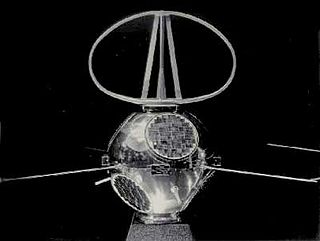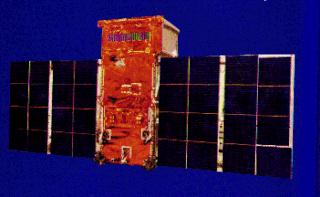Thor was a US space launch vehicle derived from the PGM-17 Thor intermediate-range ballistic missile. The Thor rocket was the first member of the Delta rocket family of space launch vehicles. The last launch of a direct derivative of the Thor missile occurred in 2018 as the first stage of the final Delta II.
Kosmos 70, also known as DS-A1 No.7 was a technology demonstration satellite which was launched by the Soviet Union in 1965 as part of the Dnepropetrovsk Sputnik programme. Its primary mission was to demonstrate technologies for future Soviet military satellites. It also conducted radiation experiments.
Kosmos 36, also known as DS-P1-Yu #1 was a satellite which was used for use in calibrating the Dnestr space surveillance and as a radar calibration target, for tests of anti-ballistic missiles. It was launched by the Soviet Union in 1964 as part of the Dnepropetrovsk Sputnik programme. It was built by the Yuzhnoye Design Bureau.
Kosmos 76, also known as DS-P1-Yu No.3 was a Soviet satellite which was used as a radar calibration target for tests of anti-ballistic missiles. It was built by the Yuzhnoye Design Bureau, and launched in 1965 as part of the Dnepropetrovsk Sputnik programme.
Kosmos 123, also known as DS-P1-Yu No.5 was a Soviet satellite which was used as a radar calibration target for tests of anti-ballistic missiles. It was built by the Yuzhnoye Design Bureau, and launched in 1966 as part of the Dnepropetrovsk Sputnik programme.
Kosmos 93, also known as DS-U2-V No.1, was a Soviet satellite which was launched in 1965 as part of the Dnepropetrovsk Sputnik programme. It was a 305 kilograms (672 lb) spacecraft, which was built by the Yuzhnoye Design Bureau, and was used to conduct classified technology development experiments for the Soviet armed forces.
Kosmos 95, also known as DS-U2-V No.2, was a Soviet satellite which was launched in 1965 as part of the Dnepropetrovsk Sputnik programme. The spacecraft weighed 325 kilograms (717 lb), and was built by the Yuzhnoye Design Office, and was used to conduct classified technology development experiments for the Soviet armed forces.
OPS 3762, also known as FTV-2355, was an American reconnaissance satellite which was launched in 1964. It was the first radar imaging satellite to be launched, and the only Quill spacecraft to fly. Its mission was to demonstrate radar imaging techniques for future missions. However, the programme was cancelled before any more satellites were launched.
Discoverer 23, also known as KH-5 9016A, was a USAF photographic reconnaissance satellite under the supervision of the National Reconnaissance Office (NRO) which was launched in 1961. It was a KH-5 ARGON satellite, based on an Agena-B. It was the second KH-5 mission to be launched, and the second to end in failure.
Discoverer 21, also known as RM-2, was an American satellite which was launched in 1961. It was a technology demonstration spacecraft, based on an Agena-B.
Discoverer 19, also known as RM-1, was an American satellite which was launched in 1960. It was a technology demonstration spacecraft, based on an Agena-B.

LOFTI-1 was an American satellite which was launched in 1961 and operated by the United States Navy and Naval Research Laboratory. It was used to conduct research into the propagation of very low frequency radio signals in the ionosphere, and to investigate if these signals could be received by submarines. A 136.17 MHz transmitter was used for this investigation.

Pegasus 1 or I, known before launch as Pegasus A, was an American satellite which was launched in 1965 to study micrometeoroid impacts in low Earth orbit. It was the first of three Pegasus satellites to be launched. The Pegasus spacecraft were manufactured by Fairchild Hiller, and operated by NASA.

Pegasus 2 or Pegasus II, known before launch as Pegasus B was an American satellite which was launched in 1965 to study micrometeoroid impacts in Low Earth orbit. It was the second of three Pegasus satellites to be launched, following the launch of Pegasus 1 three months earlier. The Pegasus spacecraft were manufactured by Fairchild Hiller, and operated by NASA.

TD-1A, or Thor-Delta 1A, was a European astrophysical research satellite which was launched in 1972. Operated by the European Space Research Organisation, TD-1A made astronomical surveys primarily in the ultraviolet, but also using x-ray and gamma ray detectors.
Kosmos 32 or Zenit-2 No.18 was a Soviet, first generation, low resolution, optical film-return reconnaissance satellite which was launched in 1964. A Zenit-2 spacecraft, Kosmos 32 was the eighteenth of eighty-one such satellites to be launched and had a mass of 4,730 kilograms (10,430 lb).
Kosmos 33 or Zenit-2 No.20 was a Soviet, first generation, low resolution, optical film-return reconnaissance satellite launched in 1964. A Zenit-2 spacecraft, Kosmos 33 was the nineteenth of eighty-one such satellites to be launched and had a mass of 4,730 kilograms (10,430 lb).
Kosmos 35 or Zenit-2 No.21 was a Soviet, first generation, low resolution, optical film-return reconnaissance satellite launched in 1964. A Zenit-2 spacecraft, Kosmos 35 was the twentieth of eighty-one such satellites to be launched and had a mass of 4,730 kilograms (10,430 lb).
Kosmos 68 or Zenit-2 No.29 was a Soviet, first generation, low resolution, optical film-return reconnaissance satellite launched in 1965. A Zenit-2 spacecraft, Kosmos 68 was the twenty-eighth of eighty-one such satellites to be launched and had a mass of 4,730 kilograms (10,430 lb).
Kosmos 107 or Zenit-2 No.34 was a Soviet, first generation, low resolution, optical film-return reconnaissance satellite launched in 1966. A Zenit-2 spacecraft, Kosmos 107 was the thirty-fifth of eighty-one such satellites to be launched and had a mass of 4,730 kilograms (10,430 lb).



